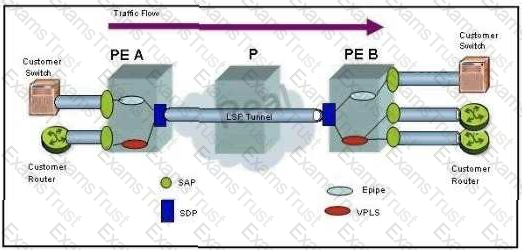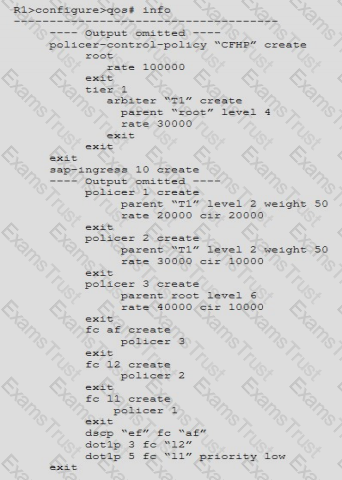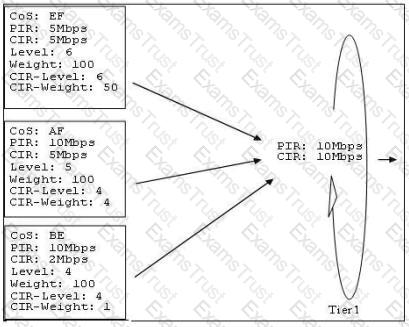To manage the shared buffer space at network ports, slope policies are applied on _________ for the ingress direction, and on ________ or _________ for the egress direction.
Traffic assigned to forwarding classes is placed into queues, while the contents of the queues are serviced in a controlled manner using____________.
Click the exhibit button below. The service provider has both a VLL (epipe) service and a VPLS, as shown in the diagram below.

At router PE B, traffic arriving from both services will have the same network-queue policy applied.
Which action does the packet remarking process perform?
Which of the following statements defines the committed information rate?
Which of the following statements describe the operation of WRED on the Nokia 7750 SR? (Choose three)
Which of the following are categories of forwarding classes on the Nokia 7750 SR? (Choose two)
For which of the following queues does a Nokia 7750 SR allocate a separate hardware queue per each destination fast forward path complex (FFPC)?
Where is a QoS network queue policy applied?
On the Nokia 7750 SR, which of the following QoS-related policies can be configured on a SAP? (Choose three)
Which parameter can be configured in a network ingress QoS policy?
Which of the following is NOT a characteristic of policing?
With hierarchical scheduling, up to ___________ tiers are supported on the Nokia 7750 SR.
What is the 6-bit binary representation of DSCP value AF21?
Which of the following statements regarding the default scheduler in the Nokia 7750 SR are TRUE? (Choose two)
How is buffer memory allocated per forwarding complex on a Nokia FP3-based IMM?
Both SAP-ingress 10 and policer-control-policy “CFHP” have been applied to a service SAP ingress.
What is the maximum bandwidth allocated to policer 2?

Which of the following statements about scheduling on the Nokia 7750 SR is FALSE?
Policing improves bandwidth utilization by using buffering to absorb high bursts of traffic.
Which of the following statements about marking packets is TRUE?
Which priority-mode queue parameter may influence both the profile marking, and scheduling priority of a queue?
A queue-group template can contain both queues and policers when applied under which conditions?
In the context of hierarchical scheduling, a scheduler is configured with a CIR weight of 0. Which of the following statements is TRUE?
When we select the adaptation rule “min”, how are the operational CIR/PIR rates of a queue calculated?
Click the exhibit button below. Given the scheduler-policy (below), which of the following can be done to guarantee that the best-effort traffic receives its configured CIR value?

Which of the following statements about a SAP-ingress policy is FALSE?
On the Nokia 7750 SR, what is the maximum number of queues that a single SAP-ingress policy can support in a VPLS?
On an Nokia IOM 3, how is buffer memory allocated per forwarding complex?
With hierarchical scheduling, up to ___________ tiers are supported on the Nokia 7750 SR.
Which of the following CANNOT be used as external marking bits?
Which of the following are examples of metrics for QoS?
On the Nokia 7750 SR, how many queues per FC are available for multipoint traffic within a VPLS on service ingress?
Which of the following fields is in the MPLS header?
Which of the following should be performed if a service provider does not want packets to make use of the shared buffer space when queued?